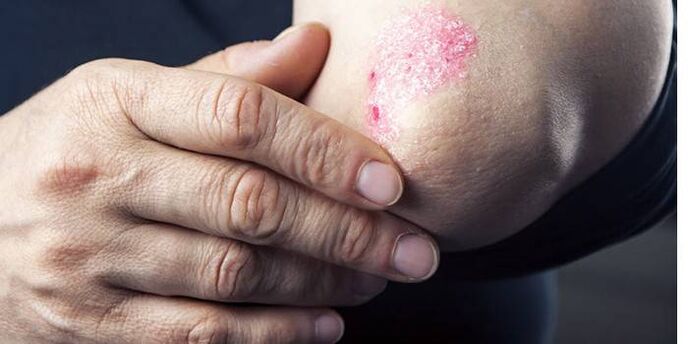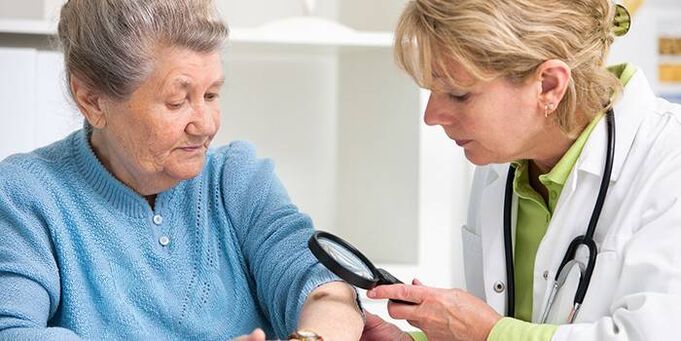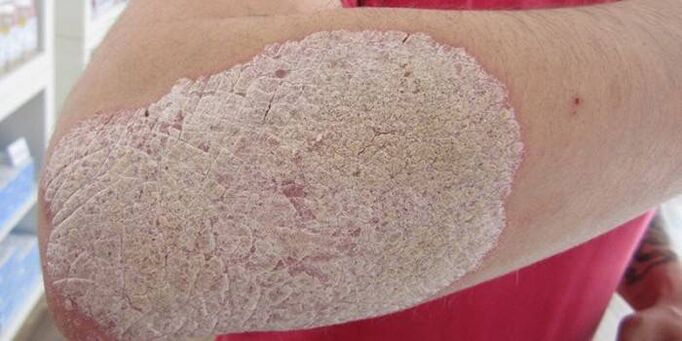Skin diseases are accompanied by the appearance of unpleasant symptoms and psychological distress. One of the most common diseases that require immediate treatment of the skin is psoriasis on the elbows, and the choice of treatment is not limited to the use of local preparations. If you do not do the therapy on time, a small inflammation will soon turn from a cosmetic problem to a medical problem.
What is psoriasis on the elbows
The disease is characterized by unpredictability and periodicity, characterized by the appearance of several spots at the site of flexion of the limbs. Psoriasis of the elbows is a chronic skin disease that begins with the appearance of papules and grows to plaques (large diffuse lesions) with white, silver, and reddish scales. Due to the accumulation of dry dead cells, slightly raised damaged areas are formed. If the inflammation is not treated, the disease will progress with periods of exacerbation and remission.
Symptoms
When crusts form on the elbows, you can immediately see the damaged areas of the skin. The symptoms of the disease are immediately apparent, and in rare cases it is possible to completely cure psoriasis in the flexion of the arms. The chances of a successful recovery are patients who see a doctor in time. The cause of concern should be a violation of the skin condition of the elbows, similar to the following symptoms of psoriasis:
- Red plaques, or scaly spots that initially resemble papules with a white layer, grow as the disease progresses and develops, become interconnected, and are covered with white scales.
- Itching of the skin, which causes more damage to the skin. Other mechanical injuries to the skin, such as scratches and cuts, such as inflammation in the elbows, shrink, damage the skin, and cause new spots to form.
- Severe redness, bleeding areas of the skin begin to bleed.

Boards on elbows
Psoriasis can occur in the groin area, trunk, limbs, or head, but no matter where the disease is localized, plaque is a sure sign. Wounds on the elbows in the form of red spots with white scales occur more often because this area of skin is exposed, because it is easy to damage. The altered area of the epidermis becomes inflamed, the red scaly spots gradually increase and may cover the entire elbow. Slabs may bleed with a careless shape, and when an attempt is made to dig, a "stearin stain" phenomenon appears, as if after a drop of hardened wax.
Reasons
Ongoing scientific research has not yet been able to pinpoint the exact source of the disease, and medical versions of the causes of psoriasis in the elbow include:
- Genetic predisposition is an important statistical factor. If one of the parents has chronic inflammation of the skin, then the child is more likely to develop psoriasis.
- The penetration of special substances that penetrate into the damaged areas of the skin. The affected areas of the epidermis begin to thicken, the body begins to struggle with abnormal symptoms, and rejects cells that appear as fungi on the elbows.
- Disorders of T-lymphocytes, which are faced with the task of creating a barrier in the face of pathogens.
- Silicone deficiency in the body.
- Endocrine diseases.
- Serious limb injuries.
- Severe mechanical injuries, incurable wounds.
- Emotional, mental stress.
- Long-term medication.
- Weak immunity.

stages
Chronic inflammatory process in the elbows, which either intensifies or decreases under the influence of a number of causes, progressing without proper treatment. The course of therapy should be prescribed by a dermatologist, but the doctor should evaluate the effectiveness of the method, the choice of drugs, the course of the disease to determine the procedure. If it is customary to distinguish the following stages of skin lesions on the elbows with psoriasis, the following tactics will depend on the clinical picture:
- Initial. The surface of the skin outside the elbows is covered with a rash. Rounded red spots with a white layer grow, are covered with scales, and after 2-3 weeks plaques are formed. With timely treatment, the symptoms of psoriasis may disappear for a while, then reappear, or the injury may occur elsewhere in the body.
- Progressive. This stage of the disease can be characterized by the presence of psoriatic elements with many scales. The appearance of such symptoms indicates the onset of exacerbation of psoriasis, and it is easy to see by the presence of a hyperemic edge (redness) on the edge of the scaly plaque.
- Stationary. It is characterized by a reduction in the inflammatory process, indicating the effectiveness of the treatment used. The appearance of new plaques on the elbows stops, there is no red edge around the psoriatic elements, their diameter decreases, and the scale completely covers the inflamed area.
- Regressive. This indicates a partial recovery, the peeling is almost imperceptible or disappears, and pigmented areas of skin appear at the site of the plaques. A set of additional measures will be aimed at preventing the exacerbation of psoriasis.

Forms
The wavy course of the disease is not the only component of the insidiousness of psoriasis when it is replaced by a spontaneous period of improvement. The severity of the inflammatory process depends on the nature of the rash, another important factor is the form. A simple (vulgar) type of disease characterized by localization of rashes on the elbows, often characterized by redness, peeling, itching. The insignificant form of the disease threatens with the appearance of complications and pustular, erythrodermatic, seborrheic psoriasis - with them the area of the lesion will expand.
How to treat psoriasis on the elbows
There are effective methods of therapy, but it will not work to completely clean the skin on the elbows, because psoriasis belongs to the group of diseases for which treatment is not possible. The whole system of complex treatment will be aimed at the maximum elimination of external symptoms. The duration of remission depends on many factors, and it is recommended to establish a treatment regimen using the following basic methods to eliminate the manifestations of psoriasis:
- local therapy (ointment, cream, lotion);
- physiotherapy procedures;
- phototherapy;
- special diet;
- intake of vitamin and mineral complexes.
Treatment of psoriasis of the elbows
Drugs are actively used in the treatment of multifactorial disease, but their effectiveness is noticeable only in combination with other means. It is common to use external medications to treat psoriasis, and if they are ineffective, the following medications may be prescribed:
- cytostatics;
- antihistamines;
- enterosorbents.
Ointment
Topical treatment is a quick way to get rid of the unpleasant symptoms of psoriasis. Ointments with vitamin D, zinc, tar are called to help remove dead cells, moisturize the skin on the elbows, and hormonal agents help to cope with more severe forms of the disease. Corticosteroids are relatively safe when used as prescribed by a physician who examines psoriatic plaques on the elbows and assesses the condition of the upper extremities and the degree of damage. Only a dermatologist can include hormonal ointments in the treatment regimen, self-medication is strictly prohibited!
Alternative treatment
Compresses, lotions, decoctions, baths can rightly be considered less useful methods of treating psoriasis. If the boards on the elbows are covered with a white film, itching, redness at home can be easily removed by immersing the affected areas in a cool herbal solution for 7-10 minutes. The composition should be chosen individually, infused with hot water, but hot baths should be avoided. Among the herbs useful for the treatment of psoriasis:
- celandine;
- chicory root;
- valerian root.

Prevention
There is no reason to believe that psoriasis will go away on its own, but self-medication is not worth it either, as there is a risk of aggravating the course of a chronic disease. Elimination of the inflammatory process is the first step to recovery, because for long-term remission you need to follow some recommendations of doctors. To prevent exacerbation of psoriasis, it is necessary to take the following preventive measures:
- follow a proper diet;
- to exclude the use of alcoholic beverages, alcohol, sweets, spicy foods;
- Get enough sleep, sleep should be at least 8 hours a day;
- to prevent mechanical damage to the skin;
- monitor the internal condition of the body;
- to develop the ability to cope with stress;
- prevention of infectious diseases, support the immune system;
- minimize contact with household chemicals.
Picture of psoriasis on the elbow

























